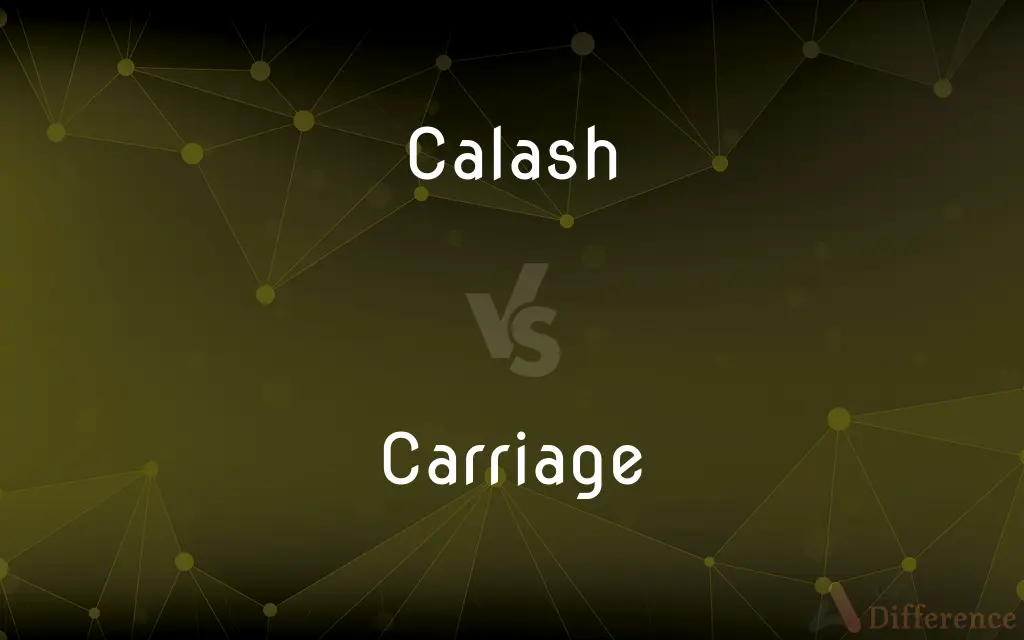Calash vs. Carriage — What's the Difference?
By Urooj Arif & Fiza Rafique — Updated on May 5, 2024
A calash is a specific type of light, horse-drawn carriage with a folding top, originally designed for leisurely or park rides, while carriage is a general term for all types of wheeled vehicles intended for passenger transport.

Difference Between Calash and Carriage
Table of Contents
ADVERTISEMENT
Key Differences
A calash, specifically known for its folding top design, was used historically for its convenience in open-air rides, allowing passengers to enjoy rides with an option for cover. In contrast, a carriage can refer to any type of horse-drawn vehicle used for transport, ranging from functional buggies to elaborate state coaches.
The calash is typically lighter and more open compared to many other carriages, making it ideal for less formal or leisurely occasions. On the other hand, carriages might be built sturdier and designed for a variety of purposes, including ceremonial events, public transport, or private luxurious travel.
Due to its specific design features, the calash often catered to the upper classes during its popular times, particularly for leisure activities in parks and country estates. Carriages, however, have been used broadly across different social strata, modified according to the needs and status of users.
The folding top of a calash provided a unique advantage for passengers desiring an open view without the commitment to remaining uncovered throughout their journey. Meanwhile, other types of carriages might feature fixed roofs, convertible tops, or no cover at all, depending on their design and intended use.
In terms of cultural significance, calashes hold a niche historical interest, often associated with 18th and 19th-century aristocracy in Europe and America. Carriages, however, have a broader historical and cultural footprint, featured prominently in everything from daily life across various eras to ceremonial and royal contexts.
ADVERTISEMENT
Comparison Chart
Design
Light, with a foldable top
Varied, from simple to elaborate
Typical Use
Leisure rides in parks and estates
Broad range, including daily transport and ceremonial use
Social Association
Often associated with the aristocracy
Used across various social classes
Roof Type
Folding top for flexible use
Fixed, convertible, or none
Historical Context
Popular in 18th and 19th centuries
Extensive historical use across times and cultures
Compare with Definitions
Calash
A type of light, two-wheeled carriage with a folding top, used especially in the 18th and 19th centuries.
They rode through the countryside in an antique calash, enjoying the spring air.
Carriage
Integral to various cultural, historical, and social narratives.
Carriages hold a romanticized place in historical novels set in the Victorian era.
Calash
Originally derived from designs popular in France and England.
The calash design was influenced by the leisurely lifestyle of French aristocrats.
Carriage
A wheeled vehicle for people, usually horse-drawn; a term encompassing everything from farm wagons to royal coaches.
The royal procession featured six ornate carriages.
Calash
Features a collapsible hood to protect against the weather.
The calash’s hood was drawn up when it started to drizzle during their outing.
Carriage
Used historically before the advent of automobiles.
Before cars, horse-drawn carriages were a common sight in city streets.
Calash
Associated with leisure and visibility.
The open design of the calash made it a favorite for public promenades.
Carriage
Varied in design to suit different terrains and social needs.
Mountainous regions used sturdier carriages with reinforced wheels.
Calash
Particularly noted for its use by women and for park rides.
The museum's display includes a calash once owned by a notable duchess.
Carriage
Can be enclosed or open, luxurious or simple, depending on the purpose.
The farmer used a simple wooden carriage for transporting goods to market.
Calash
A light carriage with two or four low wheels and a collapsible top.
Carriage
A carriage is a private four-wheeled vehicle for people and is most commonly horse-drawn. Second-hand private carriages were common public transport, the equivalent of modern cars used as taxis.
Calash
A top for this or a similar carriage.
Carriage
A wheeled vehicle, especially a four-wheeled horse-drawn passenger vehicle, often of an elegant design.
Calash
A woman's folding bonnet of the late 1700s.
Carriage
Chiefly British A railroad passenger car.
Calash
(historical) calèche
Carriage
A baby carriage.
Calash
A silk and whalebone hood worn by ladies to shade the face.
Carriage
A wheeled support or frame for carrying a heavy object, such as a cannon.
Calash
A light carriage with low wheels, having a top or hood that can be raised or lowered, seats for inside, a separate seat for the driver, and often a movable front, so that it can be used as either an open or a closed carriage.
The baroness in a calash capable of holding herself, her two children, and her servants.
Carriage
A moving part of a machine for holding or shifting another part
The carriage of a typewriter.
Calash
In Canada, a two-wheeled, one-seated vehicle, with a calash top, and the driver's seat elevated in front.
Carriage
The act or process of transporting or carrying.
Calash
A hood or top of a carriage which can be thrown back at pleasure.
Carriage
(kărē-ĭj) The cost of or the charge for transporting.
Calash
A hood, formerly worn by ladies, which could be drawn forward or thrown back like the top of a carriage.
Carriage
The manner of holding and moving one's head and body; bearing.
Calash
A woman's large folded hooped hood; worn in the 18th century
Carriage
(Archaic) Management; administration.
Calash
The folding hood of a horse-drawn carriage
Carriage
The act of conveying; carrying.
Carriage
Means of conveyance.
Carriage
A (mostly four-wheeled) lighter vehicle chiefly designed to transport people, generally drawn by horse power.
The carriage ride was very romantic.
Carriage
A railroad car
Carriage
The manner or posture in which one holds or positions a body part, such as one's arm or head.
The runner has a very low arm carriage.
Carriage
A manner of walking and moving in general; how one carries oneself, bearing, gait.
Carriage
(archaic) One's behaviour, or way of conducting oneself towards others.
Carriage
The part of a typewriter supporting the paper.
Carriage
A shopping cart.
Carriage
(British) A stroller; a baby carriage.
Carriage
The charge made for conveying (especially in the phrases carriage forward, when the charge is to be paid by the receiver, and carriage paid).
Carriage
(archaic) That which is carried, baggage
Carriage
That which is carried; burden; baggage.
David left his carriage in the hand of the keeper of the carriage.
And after those days we took up our carriages and went up to Jerusalem.
Carriage
The act of carrying, transporting, or conveying.
Nine days employed in carriage.
Carriage
The price or expense of carrying.
Carriage
That which carries of conveys,
Carriage
The manner of carrying one's self; behavior; bearing; deportment; personal manners.
His gallant carriage all the rest did grace.
Carriage
The act or manner of conducting measures or projects; management.
The passage and whole carriage of this action.
Carriage
A railcar where passengers ride
Carriage
A vehicle with four wheels drawn by two or more horses
Carriage
Characteristic way of bearing one's body;
Stood with good posture
Carriage
A machine part that carries something else
Carriage
A small vehicle with four wheels in which a baby or child is pushed around
Common Curiosities
Were calashes used only by women?
While popular among women for park rides, calashes were used by anyone who valued their practical and aesthetic design.
How have carriages influenced modern vehicle design?
Many elements such as suspension systems and aesthetic design principles in carriages have influenced modern vehicle engineering.
Can you still find calashes and carriages in use today?
While rare, both can still be found in ceremonial events, historical reenactments, and tourist attractions.
What makes a calash different from other carriages?
Its distinctive folding top and lighter, open design set it apart from other, often heavier and more enclosed carriages.
Why would one choose a calash over a typical carriage for leisure?
For its elegance, lightweight design, and the ability to enjoy an open ride with the option of cover if needed.
What maintenance does a calash require compared to a standard carriage?
Maintenance for a calash would particularly focus on the folding mechanism and lightweight structure, whereas standard carriages might require more general upkeep.
Did the design of calashes influence any other carriage styles?
Yes, the folding top concept influenced other carriage designs that sought to offer flexible options for passengers.
What are the cultural significances of carriages in history?
Carriages were significant in societal rituals, status symbols, and everyday life across various cultures and epochs.
How were carriages adapted for different social classes?
Designs varied from simple, functional carts for common use to ornate, luxurious versions for the wealthy.
How did the industrial revolution affect carriage and calash use?
The advent of the automobile during the industrial revolution led to a decline in the use of horse-drawn vehicles like carriages and calashes.
Share Your Discovery

Previous Comparison
Penguin vs. Puffin
Next Comparison
Novel vs. EpicAuthor Spotlight
Written by
Urooj ArifUrooj is a skilled content writer at Ask Difference, known for her exceptional ability to simplify complex topics into engaging and informative content. With a passion for research and a flair for clear, concise writing, she consistently delivers articles that resonate with our diverse audience.
Co-written by
Fiza RafiqueFiza Rafique is a skilled content writer at AskDifference.com, where she meticulously refines and enhances written pieces. Drawing from her vast editorial expertise, Fiza ensures clarity, accuracy, and precision in every article. Passionate about language, she continually seeks to elevate the quality of content for readers worldwide.













































